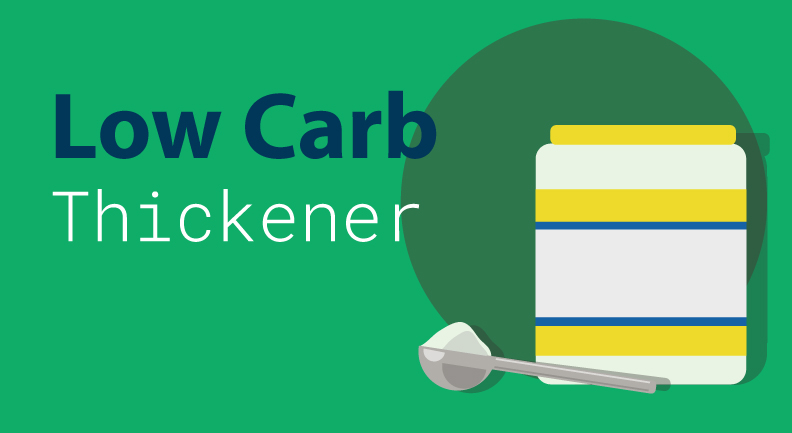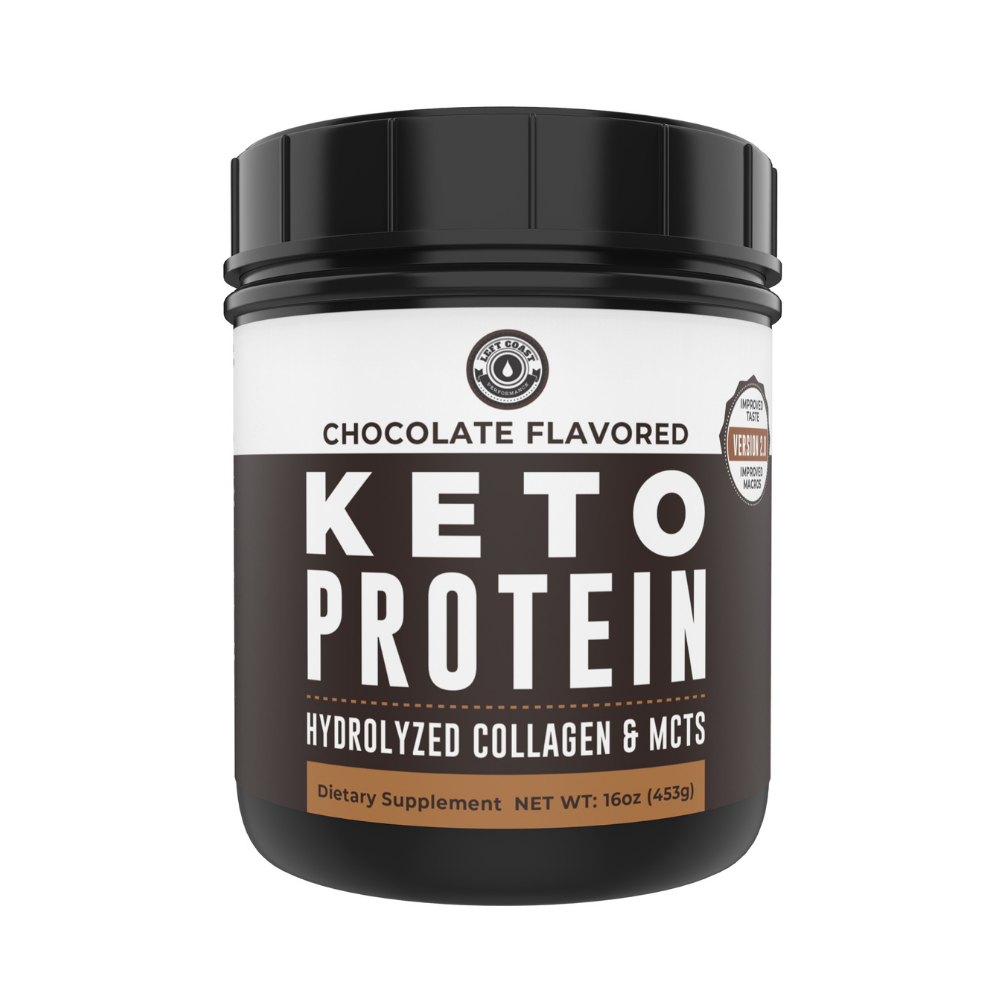The Skinny on Low Carb Thickeners

on August 22, 2019
Thickeners are a cooking and baking staple. They’re the ingredients that help make gravy so deliciously thick and that hold together the filling in fruit pies. They’re what make smoothies smooth and they even help prevent packaged cheeses from turning into a slimy, gummy mess.
Without thickeners, many recipes would be nothing more than a tasteless bowl of liquid. Simply put, some dishes just can’t be made without them. Keto followers face a unique challenge, though, because most traditional thickeners are high in carbs. So if you want to make your favorite recipes keto-friendly, you’ll need to find low-carb thickening alternatives.
In this article, we’ll explain what it takes to make a good thickener and give you four keto-approved options that will suit a range of recipes.
Most Thickeners Are High in Carbs
The most common thickening agent for cooking and baking is cornstarch. It’s made by separating the starch from corn kernels, which results in a fine white powder. When mixed with liquid and heated, it becomes a thick paste. This paste combines with the other ingredients in a recipe to add bulk and bind everything together. It works great… the problem is, cornstarch is nearly 100% carbohydrate, making it off-limits for keto followers.
So why even spend time talking about cornstarch if keto dieters can’t use it? Because if we want to find effective alternatives that mimic cornstarch in recipes, it’s helpful to have a basic understanding of how it works.
There are other thickeners aside from cornstarch. Flour can be used as a thickener, as can tapioca, gelatin, and even dates. But like cornstarch, all of these contain enough carbs to be problematic for ketosis. What we want are thickeners that don’t rely on carbohydrates for their binding properties.
What Kinds of Low-Carb Keto Thickeners Are Out There?
Unlike cornstarch and other traditional thickeners, keto thickeners don’t rely on a carbohydrate derivative to make foods stick together. They each work a bit differently and have different nutrient and flavor profiles, so the one you choose will depend on what you’re making and what you need your thickener to do.
We’ll cover one man-made and three natural low-carb thickeners below. Between them, you’re sure to find a keto-friendly thickening agent that will work for the recipe you have in mind.
Xanthan Gum
Xanthan gum is admittedly a strange ingredient. It’s synthetically made by fermenting a simple sugar using a specific type of bacteria, Xanthomonas campestris, from which it gets its unusual name. The result is a gelatinous substance that is then dried and ground into a fine powder that can be used as a thickener similar to cornstarch.
Made with sugar? Isn’t that a keto no-no? You’re right about that, but in the course of fermentation, xanthan gum becomes a type of soluble fiber (we told you it was a weird ingredient!). Soluble fiber passes straight through the digestive system without being absorbed and thus does not have an impact on blood glucose. That’s what we want in a keto thickener.
You can use xanthan gum pretty much anywhere you’d use cornstarch, including to make dressings, soups and baked goods. A little goes a long way. In some recipes, a 1:1 substitution for cornstarch will work, while others will get plenty of thickening power from just a tiny sprinkle of xanthan gum. For best results, start with too little and add more as needed, rather than using too much and winding up with a sticky mess.
One common use for xanthan gum is in frozen treats like these sugar free mint fudgsicles. They taste just like frozen chocolate pudding and have less than 2 grams of net carbs per pop.
Almond Flour
Used as an easy low-carb swap for regular flour, almond flour works well in baked goods, as breading on chicken and fish, and as a substitute for breadcrumbs in dishes like meatloaf and meatballs.
It may also bring more health benefits than traditional wheat flour since it’s made from almonds, which have been shown to raise levels of good cholesterol and promote insulin stability. A single serving of almond flour contains 35% of your recommended daily intake for Vitamin E and 31% for manganese, plus a sizable serving of protein at 6 grams. It’s rich in monounsaturated fats, which you won’t find much of in traditional flour.
Almond flour is readily available in most supermarkets, or you can make your own at home and save some money by grinding raw almonds in a food processor or high-powered blender. You can use blanched almonds (almonds with the skin removed), sliced almonds, or leave the skin on for a coarser almond meal that’s pretty much interchangeable with almond flour.
Almond flour isn’t the best thickening agent for soups and sauces for the same reason you wouldn’t typically use regular flour in these recipes; it’s not colorless like other thickeners, so it can create a cloudy appearance, and it leaves a hint of floury taste that may detract from a soup or sauce’s flavor. It’s also worthwhile to note that because of almond flour’s high-fat content, it’s higher in calories than regular flour.
Next time you’re craving breakfast in bed, try these keto almond flour pancakes. They’re light and fluffy like perfect pancakes should be, minus all the heavy carbs.
Arrowroot Powder
Extracted from the root of the arrowroot plant, arrowroot powder, also called arrowroot starch or arrowroot flour, is the closest thing you’ll get in form and function to traditional cornstarch. It’s made by drying the roots of the Maranta genus of plants (which grows in tropical climates) and grinding them into a fine powder.
Arrowroot powder is colorless and flavorless once cooked, so it can be used in those delicate sauces where flour is too heavy to be used as a thickening agent, or in clear liquids where you don’t want a cloudy appearance.
Arrowroot powder one-ups cornstarch in acidic dishes. Cornstarch tends to work better as a thickener in dairy-based dishes, whereas arrowroot works its magic in acidic environments (like recipes that call for fruit, lemon juice or vinegar). Unlike cornstarch, which holds up well under high temperatures, arrowroot powder thickens at a lower temperature. So, if you’re cooking something over high heat, arrowroot should be added at the very end rather than in the beginning to avoid clumping.
Arrowroot can generally be substituted for cornstarch in equal proportions. One teaspoon of arrowroot powder contains between 4 and 5 grams of carbs.
If you’re a devotee to cajun dishes like gumbo, you know they’re not truly authentic unless they’re made with a roux. Roux is one of those recipes where you absolutely need a good thickening agent. This is one of the places where arrowroot powder shines. To try it out, whip up this mouthwatering keto-friendly chicken, shrimp and sausage gumbo.
Flaxseed
Flaxseed is one of those ingredients that you may never have tried before going keto, but once you’re on the keto diet it’s a godsend in so many ways. Flaxseed is high in fiber and omega-3 fatty acids, as well as plant polyphenols called lignans which have plant estrogen and antioxidant qualities. It may help lower total blood cholesterol and low-density lipoprotein (LDL), the “bad” type of cholesterol. Lower cholesterol levels are associated with a lower risk of heart disease.
Most experts agree we can reap the most benefits from flaxseed by eating the seeds ground rather than whole. This is great for our purposes because ground flaxseed makes a highly effective thickening agent. You can buy ground flaxseed or make it yourself in a food processor, with a mortar and pestle or even by using a coffee grinder.
Mix ground flaxseed into soups to thicken the broth. Use it to add bulk to smoothies or to bind other ingredients in homemade granola bars. Substitute it in place of breadcrumbs when making turkey or hamburger patties.
One highly useful property of ground flaxseed is that it can be used as an egg replacement for those with egg sensitivities. To substitute for one large egg, combine 1 tablespoon of ground flaxseed with 3-4 tablespoons of water and mix well. This same combination replaces about two tablespoons of cornstarch in recipes.
One tablespoon of ground flaxseed contains just 37 calories and zero net carbs, with 3 grams of fat. Because ground flaxseed is so versatile and has a low flavor profile, it’s easy to sneak into all kinds of recipes (as a thickener or not) to up the fat count and hit your daily macros.
To see the thickening power of flaxseed in action, try these keto cinnamon bun muffins. They’re flourless and high in fiber, yet they taste just like those giant gooey cinnamon buns from a shopping mall food court. Yum.
One final benefit of using xanthan gum, almond flour, arrowroot flour or ground flaxseed in place of cornstarch and other traditional thickeners is that aside from staying in ketosis, you’ll also be adding helpful nutrients, fat and/or fiber content that your dish might not contain otherwise.
About Left Coast Performance
Left Coast Performance is your source for the scoop on keto-friendly ingredients, recipes, and nutritional supplements. Our premium products like MCT oil, bone broth powder, and electrolyte supplements will help you stay in ketosis while getting the energy and nutrients you need to fuel your day.
We offer direct-to-consumer pricing, world-class customer service and free shipping on all orders with a 100% money-back satisfaction guarantee. For more information on Left Coast Performance and to shop our selection of keto-friendly products, visit www.leftcoastperformance.com. Follow us on Instagram for more helpful keto lifestyle tips and answers to your most frequently asked keto questions.













